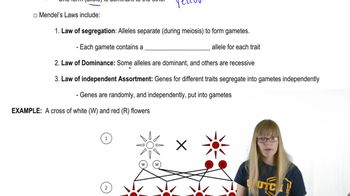What observations are consistent with the conclusion that DNA serves as the genetic material in eukaryotes? List and discuss them.
Table of contents
- 1. Introduction to Genetics51m
- 2. Mendel's Laws of Inheritance3h 37m
- 3. Extensions to Mendelian Inheritance2h 41m
- 4. Genetic Mapping and Linkage2h 28m
- 5. Genetics of Bacteria and Viruses1h 21m
- 6. Chromosomal Variation1h 48m
- 7. DNA and Chromosome Structure56m
- 8. DNA Replication1h 10m
- 9. Mitosis and Meiosis1h 34m
- 10. Transcription1h 0m
- 11. Translation58m
- 12. Gene Regulation in Prokaryotes1h 19m
- 13. Gene Regulation in Eukaryotes44m
- 14. Genetic Control of Development44m
- 15. Genomes and Genomics1h 50m
- 16. Transposable Elements47m
- 17. Mutation, Repair, and Recombination1h 6m
- 18. Molecular Genetic Tools19m
- 19. Cancer Genetics29m
- 20. Quantitative Genetics1h 26m
- 21. Population Genetics50m
- 22. Evolutionary Genetics29m
7. DNA and Chromosome Structure
DNA as the Genetic Material
Problem 20
Textbook Question
How is the absorption of ultraviolet light by DNA and RNA important in the analysis of nucleic acids?
 Verified step by step guidance
Verified step by step guidance1
Understand that DNA and RNA absorb ultraviolet (UV) light primarily due to the presence of aromatic bases (adenine, thymine, cytosine, guanine, and uracil) which have conjugated double bonds capable of absorbing UV light, especially around 260 nm wavelength.
Recognize that this absorption property allows scientists to quantify nucleic acids by measuring the absorbance of a solution at 260 nm using a spectrophotometer, based on the principle that absorbance is proportional to concentration.
Apply the Beer-Lambert Law, which relates absorbance (A) to concentration (c), path length (l), and molar absorptivity (ε), expressed as \(A = \varepsilon \times c \times l\), to calculate the concentration of nucleic acids in a sample.
Use the ratio of absorbance at 260 nm to absorbance at 280 nm (A260/A280) to assess the purity of nucleic acid samples, since proteins absorb strongly at 280 nm, and a pure nucleic acid sample typically has a ratio around 1.8 to 2.0.
Understand that this UV absorption analysis is a rapid, non-destructive method widely used in molecular biology to estimate both the quantity and purity of DNA and RNA samples before further experimental procedures.
 Verified video answer for a similar problem:
Verified video answer for a similar problem:This video solution was recommended by our tutors as helpful for the problem above
Video duration:
2mPlay a video:
Was this helpful?
Key Concepts
Here are the essential concepts you must grasp in order to answer the question correctly.
Ultraviolet (UV) Light Absorption by Nucleic Acids
DNA and RNA absorb UV light strongly at a wavelength of around 260 nm due to their aromatic nitrogenous bases. This property allows scientists to detect and quantify nucleic acids by measuring absorbance, which correlates with their concentration in a sample.
Recommended video:
Guided course

DNA Proofreading
Beer-Lambert Law in Nucleic Acid Quantification
The Beer-Lambert law relates absorbance to concentration and path length, enabling precise measurement of nucleic acid amounts in solution. By applying this law to UV absorbance data, researchers can determine the concentration of DNA or RNA accurately.
Recommended video:
Guided course

Mendel's Laws
Purity Assessment of Nucleic Acid Samples
The ratio of absorbance at 260 nm to 280 nm helps assess nucleic acid purity, distinguishing nucleic acids from protein contamination. A 260/280 ratio around 1.8–2.0 indicates relatively pure DNA or RNA, which is critical for downstream molecular biology applications.
Recommended video:
Guided course

Proteomics

 9:32m
9:32mWatch next
Master History and Experiments with a bite sized video explanation from Kylia
Start learningRelated Videos
Related Practice
Textbook Question
791
views
